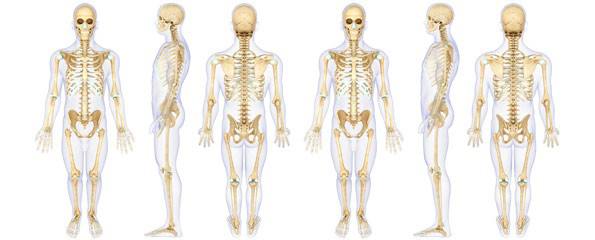Study reveals the large number of genes that affect our bones
Australian and UK scientists have shown that a large percentage of genes are likely to affect bone strength, potentially around 2,000 of the 21,000 genes in our bodies.
Identifying genes that lead to osteoporosis is an important first step in helping to treat this serious condition, which affects over 2 million Australians.
Out of 100 ‘knockout mice’, the first generated on a ‘pipeline’ set up by the UK’s Wellcome Trust Sanger Institute (as part of a global effort to knockout every gene in the genome one by one) the scientists identified 9 genes that appear to weaken or strengthen bone.
Professor Peter Croucher from Sydney’s Garvan Institute of Medical Research, in collaboration with Dr Duncan Bassett and Professor Graham Williams from Imperial College London and colleagues at the Sanger Institute, used micro-CT and digital x-ray microradiography in combination with statistics and load bearing experiments to measure whether or not each of the first 100 genes impacted upon bone. Their results are published in PLoS Genetics, now online.
“We wanted to see what screening the first 100 knockout mice off the pipeline would tell us about the impact of these genes on bone, and whether or not our approach was an effective one,” said Professor Peter Croucher.
“The approach was successful in that we identified 9 genes that had not previously been described – each of which appeared to be important in regulating our skeleton. This suggests that roughly 8-10% of all genes may be involved in some way.”
“We believe a systematic screening of knockout mice in this way will give us the scale of data we need to define the structural and functional variations in genes that determine bone strength.”
“CT scans and microradiography give us the structural information we need, and fracturing the bones afterwards tells us whether or not there is an increase or a decrease in the propensity to fracture. That’s the functional endpoint.”
“This has allowed us to describe four functional classifications of bone. Normal bone is strong and flexible, whereas abnormal bone can be strong but brittle, or weak and brittle, or weak but flexible.”
“At the moment, we’re trying to understand the potential role of the 9 genes we’ve just identified. Our results suggest that if you were to block some of them, it would result in higher bone mass and stronger bones. We’ll be making antibodies to those genes to test our results.”
“We believe that many genes will be individual players in complex pathways – so they will act as pointers to those pathways, and obviously some pathways will be much more important than others. It’s our aim to pinpoint the critical pathways.”
Source: Garvan Institute
Dates
Tags
Created by:

 Login
Login














